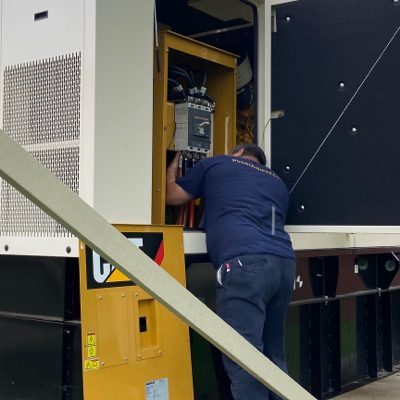Load Bank Installation
Home > Project Solutions > Permanent Load Bank Installation
Permanent Load Bank Installation
For professional load bank installation services, turn to the ESGA-certified Field Services Engineers (FSEs) at LionHeart Critical Power Specialists. We are your team to trust for a customized load bank installation at your facility.
What is a Load Bank?
A load bank is an electrical machine that has multiple rows of interior resistor elements controlled by toggle switches or a digital controller that applies precise amounts of electrical load to the power source(s).
Digital control panels now allow for the application of a load to the power system, sometimes even controlling multiple load banks from one handheld controller. Think of a space heater, or a toaster, but on a larger scale.
Most load banks are air cooled, using fans and heat sinks to dissipate the heat from the resistor elements. Very few are water cooled. There were previously brine tank load banks, but in modern times, newer units allow for a much more controlled load application to the generating set(s).
Load Bank Types
If you’re wondering, “what is a load bank type I can use for my facility?” the answer varies quite a bit.
Common types include:
- Portable
- “Suitcase” style – carried by hand or on wheels
- “Refrigerator” style – rolled around on wheels
- Trailer mounted
- Permanent installations
- Radiator mounted unit
- Pad mounted unit
Load banks also come in different configurations:
- Resistive load banks are the most common.
- Other load bank types include:
- Capacitive load banks
- Resistive reactive load banks
- Inductive load banks
What is a Load Bank Connection Cabinet?
A load bank connection cabinet, often called a tap box, can be installed to allow a safe and quick connection of cables to the box.
When designed and installed correctly within the electrical system, the tap box can also serve as a portable generator connection point, should the permanently installed standby generator fail or require down time for maintenance or repairs.
During installation of the tap box, phase rotation will be permanently determined by the installing electricians, and clearly identified at the docking station by colored cabling or specially configured camlock connections.
When configured as a portable generator connection cabinet, a temporary generator will be brought to the facility and parked near the connection cabinet. Cabling will be run from the portable generator to the tap box. Generator quick connections will be terminated at the tap box and any necessary shore power or remote start cables will also run to the temporary generator. Any necessary configurations of the breakers inside the facility may need to be adjusted, and then the portable generator will be supporting the emergency power loads, normally backed up by the permanent generator, through the automatic transfer switches.
Cabinets can be constructed in different styles, configurations, and materials. The majority of tap boxes are mounted outdoors, so NEMA 3R and stainless-steel construction may be worth looking at for your project.
What is a Load Bank with a Resistive Load?
Used for testing the generator set at the full capacity of the nameplate kW rating, load several of your generator systems from cooling to fuel with this type of load bank. With a simple load power factor of 1.0 (Unity), the voltage and current sine wave are both aligned, and their zero crossings meet at the same point in time.
Understanding resistive loads is easiest when we discuss what types of loads are resistive and inductive. For example:
- Incandescent light bulbs, toasters, space heaters, hair dryers, and hand dryers, are all resistive loads.
- Reactive, or inductive/capacitive loads are motors (chillers, elevators, pumps, etc.), VFDs, UPSs, efficient lighting systems, and (sometimes) transformers.

What is a Load Bank's Purpose?
Load banks are primarily used as testing equipment, but can also be integrated into power system design to balance uneven loads or for use as power factor correction.
Onsite power generation systems are more sensitive to an imbalance of power factor than the utility grid will be, since the emergency power generator is much smaller than the generating equipment for the power company. If your facility has large amounts of reactive load that needs to be brought within the acceptable range of the capability curve for alternators, a permanently installed automatically loading load bank may be the best option.
Did you know? Load banks can be used for testing a UPS battery system or rotary system, circuit breaker operation, loading an automatic transfer switch power panel to rated capacity, and much more. LionHeart can help to perform each of these to ensure your facility is ready to handle the load when the time comes!
Why is Load Bank Installation Needed?
Equipment for load bank testing is crucial to ensuring long-life and maximum reliability from the generator system.
Building loads are typically sized to not heavily load the generator system and to allow room for the addition of electrical loads in the future. Additionally, transferring critical loads to the generator for testing is often not practical, as these lightly loaded conditions end up creating wet stacking conditions in diesel engines, which can be harmful to its internals. This can also be a detriment as to how light loads do not effectively test the cooling system operation, which may be masking an underlying problem with the cooling package.
Load bank equipment resolves each of these concerns by periodically testing the diesel engine under heavy loads, ensuring proper operation of the cooling package, as well as increasing exhaust temperatures above the manufacturers minimum exhaust gas temperature recommendation, which reduces the effect of wet stacking in the engine.
How Often Should You Load Bank Test Your Generator?
Generators, particularly diesel engine powered sets, are normally load bank tested on an annual basis. The initial start-up of a new generator set is also a great time to conduct load bank testing, which allows you to verify that the system operates as designed in the environment to which the installation has been completed.
Some facility types in various industries (i.e. Healthcare, Data Centers, etc.) are required, either by law or contract agreements with their clients, to conduct load bank testing annually or on other regular intervals.
Occasionally, a load bank test may be required after a repair is performed to verify system operation under heavy loads. For example, if engine thermostats were replaced to alleviate an overheating condition, LionHeart FSEs may need to load bank the generator to ensure that the overheating condition was corrected.
Load Bank Installation Experts
Ensure you have an accurate load bank that fits the unique specifications of your facility by partnering with LionHeart Critical Power Specialists. We are your go-to provider of load bank installation and service.
To schedule an installation, contact us online, email us at info@LHCPS.com or call 844-LHPOWER (844-547-6937), to get started.


